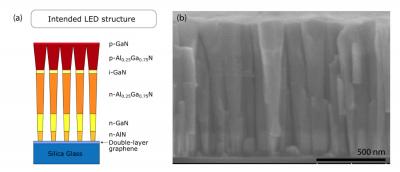A research team led by professors Helge Weman and Bjørn-Ove Fimland at the Norwegian University of Science and Technology (NTNU) has succeeded in creating ultraviolet light on a graphene surface. This could be beneficial for eliminating the toxic mercury element common in ultraviolet light devices that are used to kill bacteria and viruses.
 Nanocolumn design and SEM image of grown nanocolumns
Nanocolumn design and SEM image of grown nanocolumns
We’ve created a new electronic component that has the potential to become a commercial product. It’s non-toxic and could turn out to be cheaper, and more stable and durable than today’s fluorescent lamps. If we succeed in making the diodes efficient and much cheaper, it’s easy to imagine this equipment becoming commonplace in people’s homes. That would increase the market potential considerably, says PhD candidate Ida Marie Høiaas.
A layer of graphene placed on glass forms the substrate for the researchers’ new diode that generates UV light. Researchers have succeeded in growing nanowires of aluminium gallium nitride (AlGaN) on the graphene lattice.
The process takes place in a high temperature vacuum chamber where aluminium and gallium atoms are deposited or grown directly on the graphene substrate with high precision and in the presence of nitrogen plasma. This process is known as molecular beam epitaxy (MBE) and is conducted in Japan, where the NTNU research team collaborates with Professor Katsumi Kishino at Sophia University in Tokyo.
After growing the sample, it is transported to the NTNU NanoLab where the researchers make metal contacts of gold and nickel on the graphene and nanowires. When power is sent from the graphene and through the nanowires, they emit UV light.
Graphene is transparent to light of all wavelengths, and the light emitted from the nanowires shines through the graphene and glass.
It’s exciting to be able to combine nanomaterials this way and create functioning LEDs, says Høiaas.
Concurrently with her PhD research at NTNU, Høiaas is working with the same technology on an industrial platform for CrayoNano, a spinoff of NTNU’s nano research environment.
UVC LEDs that can replace fluorescent bulbs are already on the market, but CrayoNano’s goal is to create far more energy-efficient and cheaper diodes. According to the company, one reason that today’s UV LEDs are expensive is that the substrate is made of costly aluminium nitride. Graphene is cheaper to manufacture and requires less material for the LED diode.
Høiaas believes that the technology needs to be improved quite a bit before the process developed at NTNU can be scaled up to industrial production level.
Among the issues that need to be addressed are conductivity and energy efficiency, more advanced nanowire structures and shorter wavelengths to create UVC light. CrayoNano has made progress, but results documenting their progress have not yet been published.
CrayoNano’s goal is to commercialize the technology sometime in 2022, says Høiaas.